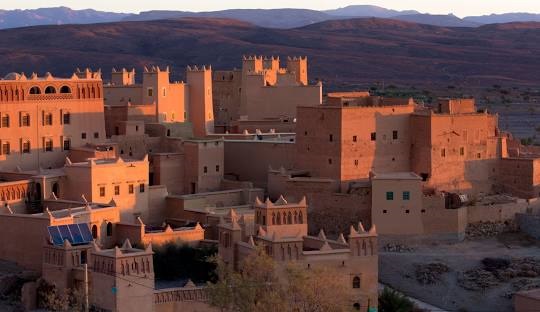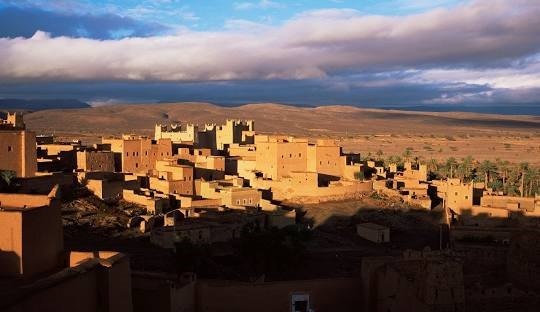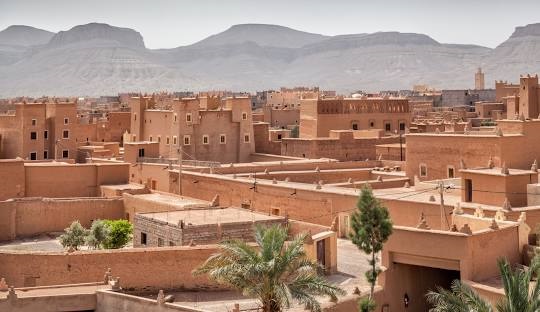To trek in Morocco, with Riad Nkob, offers an exhilarating combination of stunning landscapes, rich cultural experiences, and varied terrain that caters to all types of trekkers, from beginners to seasoned adventurers. Morocco is a country blessed with diverse geography, including the towering peaks of the Atlas Mountains, the vast expanse of the Sahara, and the rugged beauty of the Rif Mountains.
Trek In Morocco
Whether you’re seeking a challenging climb to the summit of North Africa’s highest peak, Jebel Toubkal, or a leisurely trek through lush valleys and Berber villages, the Kingdom provides a unique backdrop that is both captivating and unforgettable. The Atlas Mountains are perhaps the most famous destination to trek in Morocco, and for good reason.
This mountain range, which stretches over 2,500 kilometers across the country, is divided into three main sections : the High Atlas, the Middle Atlas, and the Anti-Atlas. The High Atlas is home to Morocco’s highest peaks, including Jebel Toubkal, which stands at 4,167 meters. The trek to the summit of Toubkal is one of the most popular in Morocco and offers breathtaking views of the surrounding mountains and valleys.
The journey typically begins in the small village of Imlil, a traditional starting point to trek in Morocco. From there, the adventure involves a mix of steep ascents, rocky paths, and, in winter, snow-covered slopes that require crampons and an ice axe. The ascent to Toubkal can be done in two days, but many trekkers choose to spread the journey over three to four days to acclimatize properly and fully enjoy the scenery.
The route passes through small Berber villages, where trekkers can experience the warm hospitality of the local people and learn about their traditional way of life. Along the way, trekkers are treated to stunning views of terraced fields, walnut groves, and rugged mountain landscapes. The Middle Atlas is less frequented by tourists, making it an ideal destination for those seeking solitude and a more off-the-beaten-path experience.
This region is characterized by cedar forests, rolling hills, and hidden lakes. One of the highlights to trek in Morocco, on the Middle Atlas, is the opportunity to see Barbary macaques, a species of monkey native to the region. Treks in the Middle Atlas often start from the town of Azrou, which is known for its traditional souks and artisanal crafts.
From Azrou, trekkers can explore the surrounding forests and mountains, including the beautiful Michlifen ski resort and the peaceful Dayet Aoua lake. The terrain in the Middle Atlas is really less challenging than in the High Atlas, making it suitable for families and those looking for a more relaxed trekking experience.
The Anti-Atlas is a lesser-known mountain range in southern Morocco, offering a stark contrast to the lush valleys and snow-capped peaks of the High Atlas. The landscape here is arid and rugged, with jagged peaks, deep gorges, and isolated oases. This region is perfect to trek in Morocco, if you are looking for a more remote and adventurous experience.
One of the most popular treks in the Anti-Atlas is the ascent of Jebel Sirwa, a volcanic mountain that stands at 3,304 meters. The trek to the summit takes about three to four days and offers spectacular views of the surrounding desert landscape. Along the way, trekkers will encounter traditional Berber villages, where they can learn about the local culture and traditions.
The Sahara desert is another iconic destination to trek in Morocco, offering a completely different experience from the mountainous regions of the country. Trekking in the Sahara involves walking through vast expanses of sand dunes, rocky plateaus, and ancient caravan routes. The desert landscape is both beautiful and challenging, with extreme temperatures and unpredictable weather conditions.
Erg Chebbi is one of the most famous sand dune systems in the Sahara and is located near the town of Merzouga in southeastern Morocco. The dunes here can reach heights of up to 150 meters and offer a stunning backdrop for a desert trek. A typical trek in Erg Chebbi involves walking from one dune to another, camping under the stars, and experiencing the silence and solitude of the desert.
To trek in Morocco, around Erg Chebbi, is an opportunity to enjoy camel rides, which are a traditional mode of transport in the desert. The sight of a caravan of camels crossing the dunes at sunset is a quintessential image of the Sahara and an unforgettable experience for any trekker. The local Berber guides who accompany trekkers are knowledgeable about the desert environment and can share stories about the history and culture of the region.
Erg Chigaga is a more remote and less touristy dune system than Erg Chebbi, located further south near the town of M’Hamid. The dunes here are even more expansive, stretching for over 40 kilometers and offering a true sense of isolation and wilderness. Trekking in Erg Chigaga is a more challenging and adventurous experience, requiring a good level of fitness and preparation.
The trek in Morocco to Erg Chigaga usually involves a combination of walking and camel trekking, with nights spent camping in traditional Berber tents or under the open sky. The journey takes trekkers through a variety of desert landscapes, including salt flats, rocky outcrops, and small oases. The experience of trekking in Erg Chigaga is one of true immersion in the desert environment, with few signs of civilization and a sense of timelessness.
The Rif Mountains, located in the northern part of Morocco, are often overlooked by trekkers in favor of the more famous Atlas Mountains and Sahara desert. However, the Rif offers a unique trekking experience with its lush green valleys, dense forests, and picturesque villages. The region is known for its mild climate, making it a great destination for trekking year-round.
The blue-painted town of Chefchaouen, nestled in the Rif Mountains, is a popular starting point to trek in Morocco. From here, trekkers can explore the Talassemtane National Park, which is known for its diverse flora and fauna, including cedar forests, waterfalls, and rare bird species. It offers a range of trekking routes, from short day hikes to multi-day treks.
One of the most popular treks in the Rif Mountains is the hike to the Akchour Waterfalls, a beautiful series of cascades located about 30 kilometers from Chefchaouen. The trail to these waterfalls follows a river through a scenic valley, passing through small farms and traditional villages. The trek is relatively easy and can be completed in a day, making it a great option for families and casual hikers.
For a more challenging trek in Morocco, around the Rif Mountains, trekkers can tackle the ascent of Jebel el-Kelaâ, a prominent peak that offers stunning views of the surrounding mountains and valleys. The trek to the summit takes about two days and involves a steep climb through pine forests and rocky terrain. Along the way, trekkers will pass through remote villages and have the opportunity to experience the traditional way of life in the Rif.
One of the highlights of trekking in Morocco is the opportunity to interact with local communities and learn about their culture and traditions. The Berber people, who inhabit many of the mountainous regions of Morocco, are known for their hospitality and resilience. Trekkers are often welcomed into Berber homes and offered traditional meals, such as tagine, a slow-cooked stew, and couscous.
In addition to experiencing the hospitality of the Berber people, to trek in Morocco is also an opportunity to visit local traditional markets, where you can shop for handmade crafts, spices, and textiles. The traditional markets are a vibrant and colorful part of Moroccan culture, and visiting them is a great way to learn about the local way of life.
Trekking in Morocco requires some preparation and planning to ensure a safe and enjoyable experience. Here are a few practical considerations to keep in mind. The best time to trek in Morocco depends on the region and the type of trek you are planning. For the High Atlas Mountains, the best time to trek is from April to October, when the weather is mild and the trails are mostly free of snow.
The best time to trek in Morocco, around the Sahara desert, is from October to April, when temperatures are cooler and more manageable. The Rif Mountains can be trekked year-round, but the best time to visit is in spring and autumn when the weather is pleasant. For those trekking in the High Atlas Mountains, it is important to be aware of the risks of altitude sickness, especially if you are planning to climb Jebel Toubkal or other high peaks.
Acclimatization is key to preventing altitude sickness, so it is recommended to spend a few days at a moderate altitude before attempting any high-altitude treks. It is also important to stay hydrated and listen to your body, descending if you experience symptoms of altitude sickness. While it is possible to trek independently in Morocco, hiring a local guide and porters is highly recommended, especially for longer or more challenging treks.
Local guides are knowledgeable about the terrain, weather conditions, and local culture, and can enhance your trekking experience with their insights and stories. Porters can help carry your gear, allowing you to focus on enjoying the trek. When packing for a trek in Morocco, it is important to bring appropriate clothing and equipment for the terrain and weather conditions.
For mountain treks, layers are key, as temperatures can vary greatly between day and night. A good pair of hiking boots, a warm jacket, and a hat and gloves are essential. For a desert trek in Morocco, lightweight, breathable clothing, a wide-brimmed hat, and sunscreen are important to protect against the sun. Trekking in Morocco is a great opportunity to learn about local customs and traditions, and it is important to respect the local culture and environment.
This includes dressing modestly, especially in rural areas, and being mindful of local customs and etiquette. It is also important to follow principles such as packing out all trash and minimizing your impact on the environment. To trek in Morocco offers a diverse and rewarding experience for adventurers of all levels.
From the challenging peaks of the Atlas Mountains to the vast expanses of the Sahara desert and the hidden gems of the Rif Mountains, Morocco’s varied landscapes provide a stunning backdrop for any trek. Coupled with the opportunity to experience the rich culture and hospitality of the local people, to trek in Morocco is an adventure that promises to be both memorable and transformative.



